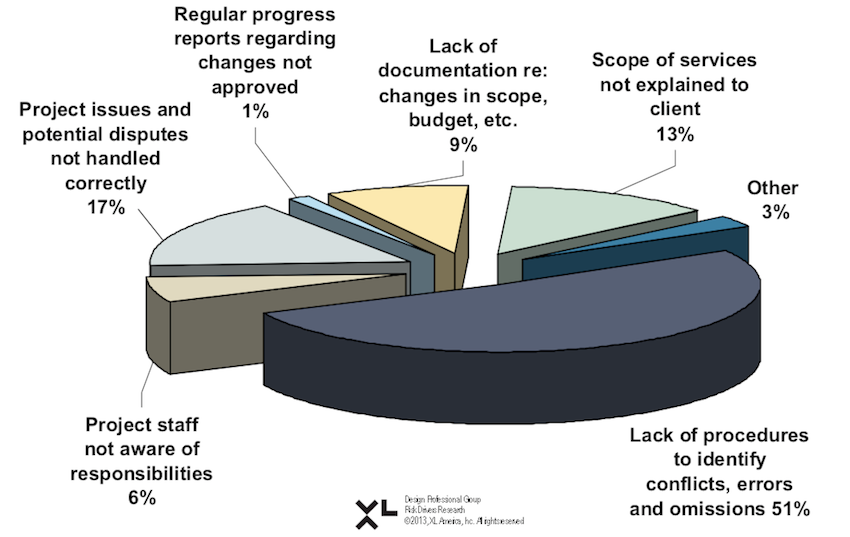Risk Management 101
In a professional design practice, there are 6 main management facets, discussed under the corresponding hexagonal links above right:
Practice, Client Relationships, Risk, Quality, Design, and Projects.
This entry is a brief overview of Risk Management (RM).
Risk Management
RM is, first, about being aware of a basic fact of design practice: Every decision, without exception, involves risk. Second, managing risk is about making the “right calls” on risk assessment and action.
Managing Practice Risk
The basic rule in practice risk is that anybody can sue anyone for anything at any time. Whether or not the claim will succeed is another matter, but the reality of professional indemnity insurance (which protects you from these actions) always has a substantial deductible, or excess, meaning that you pay the first part of defending the claim, whether it’s reasonable or not.
The second rule is that insurance companies make a commercial decision as to the winnability of the claim and the cost to defend against the action. If the insurer can settle the claim for less than these probable costs, they will settle. You will pay the full amount of the excess up to that settlement, and they will pay the rest. Your excess amount is very likely to go up and your premium will likely be raised on renewal.
In Australia, roughly half of all claims against architects are directly or indirectly caused by a breakdown in communication between client and architect – a completely manageable problem. In the US, recent claims data shows that about 40% of claims result from communications problems, up from about a quarter a decade earlier.
Another very interesting result of current US claims data is that half of claims result from a lack of procedures to identify conflicts, errors and omissions.
Data source: XL Group.
These two graphics are not contradictory; they are just different views of the same data in the same database.
In my view, this data convincingly points to a widespread lack of risk awareness in design practices.
Project Risk Assessment
Every firm does some level of project risk assessment – but most of it is “by the seat of the pants”, based on often-faulty memory of past projects, and is rarely systematic or objective.
The more common risk “evaluation” is heavily coloured by how badly the firm wants the project; those involved tend to simply overlook the warning signs and decide to “work it out later”.
Every firm needs a simple “Go – NoGo” assessment methodology that is resistant to manipulation to produce comforting but flawed conclusions.
This doesn’t mean that every project undergoes this scrutiny – but it means that all projects for new clients, for past “problem” clients, and where project circumstances are not straightforward, do.
Design Contract Negotiation
By definition, any negotiation means that negotiators have “something to give away”, to get what they need out of the deal. A large percentage of inexperienced designers don’t understand the negotiation process, so they go in with what they see as their “best offer” and then see it eroded into a marginal deal at the hands of the more experienced client.
Every negotiation requires that you know exactly where your “walk” position is, and are not afraid to exercise it.
Contract negotiation is a learned art form, and requires training and practice.
Internal Risk Mitigation
Mitigating project risk to the practice is mostly about maintaining awareness of risk issues: tracking them, following up on them, reporting on them, and generally ensuring that important issues do not “slip through the cracks”. Setting up and maintaining a risk log is critical.
There are a number of warning signs that typically show that risk is rising; these will be addressed in a DNode Document in the near future.
Continual Improvement
Continual improvement is where risk and quality management come together. ISO 9001 requires that any situations where quality systems start to fail are reported and actioned promptly – and these are exactly the same situations that cause risk issues on projects.
Managing Project Risk
At its simplest, managing project risk means:
- Not getting blamed for time and cost growth;
- Not permitting substandard or nonconforming construction;
- Not doing free redesign work because the contractor wants to save money;
- Completing all time-sensitive obligations on or ahead of schedule; and
- Ensuring that you act impartially to protect client, contractor and the public.
It’s never that simple, of course. These few words cannot begin to summarize the complexity of the function. Future documents will highlight key issues not generally understood or appreciated by many designers, and there is a very good reading list at designnode.net/risk-resources.
DesignRisk Tools
The DesignRisk web app (designrisk.net) is your tool of choice guide you confidently through the Go – NoGo decision, understand how to change your approach to safely take on otherwise risky projects, and provide you with mitigation guidance to protect your firm from claims.

